XXXX - OPOD
The Fascinating World of Atmospheric Optics: Exploring the Four Bows
Atmospheric optics is a captivating field that unveils the hidden wonders of light and its interactions with the Earth's atmosphere. One intriguing phenomenon within this realm is the appearance of multiple rainbows, known as bows. While most of us are familiar with the primary and secondary bows, there are actually two more bows that can occasionally grace the sky, creating a breathtaking spectacle. In this article, we will delve into the mesmerizing world of atmospheric optics and explore the lesser-known third and fourth bows.
The Third Bow: A Reflection Rainbow
Between the well-known primary and secondary bows, a third bow emerges at a peculiar angle, capturing the attention of those fortunate enough to witness its ethereal beauty. This third bow is aptly named a 'reflection' rainbow. Unlike its counterparts, the reflection rainbow is not formed by direct sunlight interacting with raindrops. Instead, it arises from the reflection of sunlight off calm water or even flat, wet beach sand.
To a rainbow, it appears as though a second sun is shining from beneath the water's surface. This imaginary sun creates a rainbow with its center seemingly in the sky, adding an enchanting layer to the atmospheric panorama. Imagine standing by a serene lake or on a tranquil beach, witnessing this extraordinary sight unfold before your eyes.
The Fourth Bow: A Reflected Bow
If the third bow wasn't captivating enough, nature has yet another surprise in store for us. Below the horizon, another bow can occasionally be observed. This bow is called a 'reflected' bow. The rays of sunlight that have already undergone refraction and reflection by raindrops now reflect once again from calm water surfaces.
As these reflected rays bounce off the water, they create a stunning mirrored bow below the horizon. This unique phenomenon adds an extra dimension to the atmospheric display, captivating both scientists and nature enthusiasts alike. Picture yourself gazing out over the ocean, witnessing the primary and secondary bows in the sky above, while a mirrored bow emerges from the calm waters below the horizon. Truly a sight to behold!
Exploring the Science Behind the Bows
To fully appreciate the beauty of these additional bows, it is essential to understand the scientific principles that govern their formation. The primary and secondary bows arise from the refraction and reflection of sunlight within raindrops. However, for the third and fourth bows, different mechanisms come into play.
For the reflection rainbow, sunlight undergoes reflection off a calm water surface or wet sand, resulting in a second imaginary sun beneath the water. The rays from this "sun" refract and reflect within raindrops, ultimately creating the reflection rainbow. This process adds a touch of magic to the scene, as if nature itself is performing an enchanting trick.
In the case of the reflected bow, sunlight first refracts and reflects within raindrops, creating the primary and secondary bows in the sky. However, these rays then reflect off calm water surfaces, forming a mirrored bow below the horizon. This dual reflection phenomenon adds complexity and depth to the atmospheric optics display, leaving observers in awe of nature's intricate workings.
Captivating Moments Around the World
The appearance of these additional bows is a rare occurrence, making them even more captivating to witness. Here are a few examples of mesmerizing sightings from different parts of the world:
-
Sarah Sayers spotted the third bow at Killult Pier in Gortnhork, Donegal, Ireland. The reflection rainbow created an otherworldly spectacle against the backdrop of calm waters.
-
Imagine standing on a pristine beach in Hawaii, witnessing the fourth bow emerge below the horizon as the sun sets over the Pacific Ocean. The mirrored bow adds an extra touch of wonder to an already breathtaking view.
-
Travel to Norway's stunning fjords, where the primary and secondary bows grace the sky, reflecting off the calm waters below. If you're lucky, you might even catch a glimpse of the reflection rainbow or the mirrored bow, creating a symphony of colors in this picturesque setting.
Unveiling Nature's Secrets
The existence of these additional bows is a testament to the intricate interplay between light, water, and atmospheric conditions. As scientists continue to explore the realm of atmospheric optics, these phenomena serve as reminders of the endless wonders nature has to offer.
Through their study, researchers gain insights into the behavior of light, the properties of water droplets, and the complex interactions that lead to the formation of rainbows. Each observation brings us closer to unraveling the mysteries of our atmosphere and deepening our understanding of the natural world.
Conclusion
The world of atmospheric optics is a treasure trove of captivating phenomena, and the four bows are a testament to its boundless beauty. While the primary and secondary bows have long captured our fascination, the third and fourth bows add an extra layer of enchantment to the atmospheric panorama.
Whether it be the reflection rainbow, creating an imaginary sun beneath calm waters, or the reflected bow, mirroring the primary and secondary bows below the horizon, each sighting leaves us in awe of nature's intricate workings. So next time you find yourself gazing at the sky or standing by a body of water, keep an eye out for these elusive bows, for they hold within them a world of wonder waiting to be discovered.

Four Bows ~ Between the well known primary and secondary bows, a third shoots up at a strange angle. A fourth is in the sea. Seen by Sarah Sayers at Killult Pier, Gortnhork, Donegal, Ireland.
The third bow is a 'reflection' rainbow. Sunlight is reflected upwards from calm water (or even flat and wet beach sand).
To a rainbow it looks as though a second sun is shining from beneath the water. the second sun forms a rainbow with its centre in the sky.

The bow below the horizon is a 'reflected' bow. Rays already refracted and reflected by raindrops reflect again from the calm water.
Note: this article has been automatically converted from the old site and may not appear as intended. You can find the original article here.
Reference Atmospheric Optics
If you use any of the definitions, information, or data presented on Atmospheric Optics, please copy the link or reference below to properly credit us as the reference source. Thank you!
-
<a href="https://atoptics.co.uk/blog/xxxx-opod-3/">XXXX - OPOD</a>
-
"XXXX - OPOD". Atmospheric Optics. Accessed on November 26, 2024. https://atoptics.co.uk/blog/xxxx-opod-3/.
-
"XXXX - OPOD". Atmospheric Optics, https://atoptics.co.uk/blog/xxxx-opod-3/. Accessed 26 November, 2024
-
XXXX - OPOD. Atmospheric Optics. Retrieved from https://atoptics.co.uk/blog/xxxx-opod-3/.